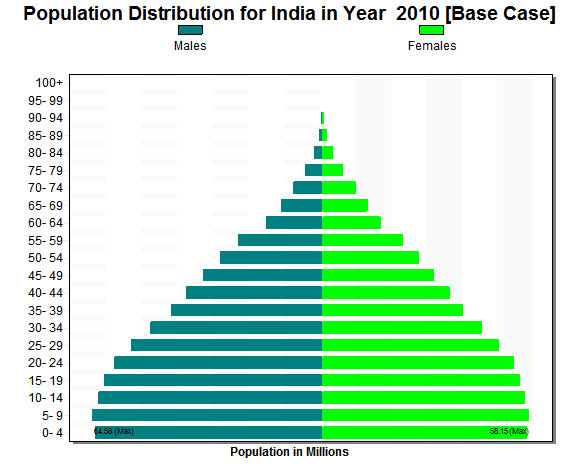Population
Crude death rate (CDR)
From population.bas:
"There are three numbers that capture fertility: TFR, CBR, the fertility distribution. There are three numbers that caputure mortality: LIFEXP, CDR, mortality distribution. They will not be completely compatible. The distributions must be used to handle cohort dynamics. But they may not be available for all countries (e.g. Taiwan, Palestine), whereas the others are. For many years we used CBR and CDR to adjust the distributions and then calculated TFR and LIFEXP from them. Over time, TFR and LIFEXP have become the key variables that dynamically drive the population model, and good data are now available. We have therefore switched over to them as the bases for initial conditions of the model, calculating CBR and CDR from them, giving us also POPR." <header><hgroup>
Demography/Population
Overview
The most recent and complete demographic model documentation is available on Pardee's website. Although the text in this interactive system is, for some IFs models, often significantly out of date, you may still find the basic description useful to you.
The population sub-model of IFs uses the cohort component analysis approach of many population models, including the studies done by the United Nations (United Nations, 1956 and 1977). The structure of the IFs population model drew initially on the World Integrated Model (WIM) or the second generation Mesarovic-Pestel Model (Hughes, 1980), but has changed much over time. In particular, José Solórzano and Randall Kuhn have made many contributions to its development.
The approach relies upon age, fertility, and mortality distributions for each country/region with 22 cohorts: one for infants, 20 of five-year size, and one for all individuals of age 100 or older. A major advantage of five-year cohorts is that data sources generally present demographic data in that form. Ideally, however, the cohort size should correspond to the model time step so as to avoid "numerical diffusion," the propagation of change from a five-year cohort to an adjoining cohort in a single year. To prevent such numerical diffusion, IFs actually runs an age distribution with 100 single-year cohorts and advances that over time, collapsing to 22 cohorts only for the calculations of births and deaths.
Because extensions of life expectancy are occurring steadily and there is at least the possibility of substantial breakthroughs, the IFs project has also created the option of extending the number of cohorts from 22 up to as many as 42 (allowing separate representation of age categories up to 200+). The capability is normally turned off, but instructions for turning on extended aging can be found here. <header><hgroup>
Structure and Agent System: Demographic
System/Subsystem
|
Demographic
|
Organizing Structure
|
Cohort-component
|
Stocks
|
Population by age-sex
|
Flows
|
Birth, death, migration
|
Key Aggregate Relationships (illustrative, not comprehensive)
|
Life expectancy (from health model)
|
Key Agent-Class Behavioral Relationships (illustrative, not comprehensive)
|
Household fertility and migration |
Humans as individuals within households interact in larger demographic systems or structures. The computer model should represent the behavior of such households, such as decisions to have children or to emigrate. And it should represent the larger demographic structures that incorporate the decisions of millions of such households. A typical approach to representing such demographic systems is through age-sex cohort distributions (see the figure below showing an example from the model). IFs also uses fertility and mortality distributions by age and sex and tracks migration across countries.
Demographers have widely accepted the representation of demographic systems and the development of demographic models with cohort-component structures. In fact, the United Nations, the U.S. Census Bureau, and the International Institute for Applied Systems Analysis (IIASA), pre-eminent demographic forecasting institutions, all use cohort-component modeling (O’Neill and Balk 2001)
